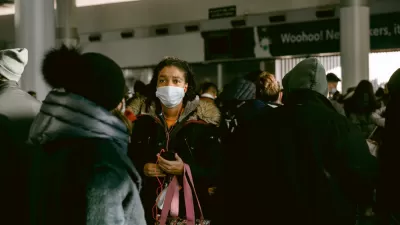With coronavirus Infections decreasing and vaccinations increasing throughout the nation, health and science reporters are writing about what the end of the pandemic may look like—from a disease perspective.

Pandemic, epidemic, endemic: three words that help to describe where we are and where we may be headed in the COVID-19 pandemic that the World Health Organization declared on March 11, 2020.
A recent post asked 20 urban experts, "What will be the lasting effects of the pandemic on urban life and urban systems?" To answer, it would be helpful to know the future of the virus in the United States that has upended our lives.
An earlier blog post by Michael Lewyn generated comments by asking, "What's wrong with COVID-friendly planning and zoning?" Michael's answer:
For one thing, COVID-19 won’t last forever—and it might not even last all year. Other worldwide epidemics (such as the 14th century Black Death, and the 1918-20 "Spanish Flu") eventually disappeared, despite the absence of modern medical technology. COVID-19 is likely to ebb eventually as well, though perhaps less rapidly in the United States than in nations that are aggressively vaccinating their citizenry.
Health reporter Erin Allday begins her deep dive into the future of COVID-19 for the San Francisco Chronicle on Jan. 24 by exploring the last pandemic of the 19th century for clues.
More than 130 years ago, a brutal respiratory virus swept across the globe, killing a million people out of a worldwide population of 1.5 billion before fading away, eventually overshadowed in history by the deadlier 1918 influenza pandemic. [Global death toll of COVID-19 on Jan. 28: almost 2.2 million].
That 1890 pandemic, which some scientists believe was caused by a coronavirus, may offer a glimpse of the modern world’s escape from COVID-19 — or at least one possible path in a future that’s still largely clouded by uncertainty.
Allday suggests three scenarios of where the deadly coronavirus, responsible for having taken almost 431,000 American lives as of Jan. 27, is heading, noting that "with several variants of the virus emerging, including one or more that could make the vaccines less effective, it’s increasingly unclear what the finish line looks like."
Michael Greshko, a science writer for National Geographic, also looks at the 1890 pandemic, known as the Russian Flu of 1889, in the source article for this post—a shorter piece than Allday's as he considers just one end for the highly contagious disease that has infected almost 26 million Americans as of Jan. 27.
As COVID-19 continues to run its course, the likeliest long-term outcome is that the virus SARS-CoV-2 becomes endemic in large swaths of the world, constantly circulating among the human population but causing fewer cases of severe disease. Eventually—years or even decades in the future—COVID-19 could transition into a mild childhood illness, like the four endemic human coronaviruses that contribute to the common cold.
As for the 1890 pandemic, Greshko cites the 2005 study published in the Journal of Virology that suggests that one of the four human cold viruses may be the offspring of the pathogen that killed one million people over 130 years ago.
Based on the spread of its family tree, researchers estimated in 2005 that the endemic coronavirus OC43 entered humans sometime in the late 19th century, likely the early 1890s. The timing has led some researchers to speculate that the original version of OC43 may have caused the “Russian flu” pandemic of 1890, which was noted for its unusually high rate of neurological symptoms—a noted effect of COVID-19
The New York Time's science and global health reporter, Apoorva Mandavilli, arrives at a similar scenario in her piece published on Jan. 12.
The coronavirus is here to stay, but once most adults are immune — following natural infection or vaccination — the virus will be no more of a threat than the common cold, according to a study published in the journal Science on Tuesday.
“The timing of how long it takes to get to this sort of endemic state depends on how quickly the disease is spreading, and how quickly vaccination is rolled out,” said Jennie Lavine, a postdoctoral fellow at Emory University in Atlanta, who led the study.
The last words go to the World Health Organization, the organization that ultimately decides when the pandemic ends. First, we hear from Dr. Michael Ryan, director of the WHO Health Emergencies Programme, as noted in a post last May based on reporting by Reuters.
“It is important to put this on the table: this virus may become just another endemic virus in our communities, and this virus may never go away...I think it is important we are realistic and I don’t think anyone can predict when this disease will disappear," said Ryan in a press conference on May 13.
More recently, David L. Heymann, MD, chair of WHO’s Strategic and Technical Advisory Group for Infectious Hazards, offered a more definitive end along the lines reported by Allday, Greshko and Mandavilli, as reported by Healio journalist Caitlyn Stulpin, on Jan. 4, 2021.
"[V]accines and good public health practice will help the world 'learn to live with COVID-19,'" said Heyman during a recent WHO briefing.
“It appears at present that the destiny of SARS-CoV-2 is to become endemic, as have four other human coronaviruses, and that it will continue to mutate as it reproduces in human cells, especially in areas of more intense transmission,” said Heymann, a professor of infectious disease epidemiology at the London School of Hygiene & Tropical Medicine.
Related in Planetizen:
-
North Dakota's Mask Mandate Expires as Infections Plummet [see header: Herd immunity on the horizon?], Jan. 24, 2021
-
BLOG POST: Against 'Pandemic-Friendly' Planning: Since COVID-19 won't last forever, planners should not act as if it will, January 4, 2021
- Pandemic Endgame: The Goalposts are Moving, December 30, 2020
- Pandemic Endgame, May 18, 2020
- Report: Expect to Live with Two More Years of Social Distancing, May 4, 2020
- Coronavirus Declared a Pandemic. What Does That Mean? March 12, 2020
FULL STORY: COVID-19 will likely be with us forever. Here's how we'll live with it.

Maui's Vacation Rental Debate Turns Ugly
Verbal attacks, misinformation campaigns and fistfights plague a high-stakes debate to convert thousands of vacation rentals into long-term housing.

Planetizen Federal Action Tracker
A weekly monitor of how Trump’s orders and actions are impacting planners and planning in America.

In Urban Planning, AI Prompting Could be the New Design Thinking
Creativity has long been key to great urban design. What if we see AI as our new creative partner?

King County Supportive Housing Program Offers Hope for Unhoused Residents
The county is taking a ‘Housing First’ approach that prioritizes getting people into housing, then offering wraparound supportive services.

Researchers Use AI to Get Clearer Picture of US Housing
Analysts are using artificial intelligence to supercharge their research by allowing them to comb through data faster. Though these AI tools can be error prone, they save time and housing researchers are optimistic about the future.

Making Shared Micromobility More Inclusive
Cities and shared mobility system operators can do more to include people with disabilities in planning and operations, per a new report.
Urban Design for Planners 1: Software Tools
This six-course series explores essential urban design concepts using open source software and equips planners with the tools they need to participate fully in the urban design process.
Planning for Universal Design
Learn the tools for implementing Universal Design in planning regulations.
planning NEXT
Appalachian Highlands Housing Partners
Mpact (founded as Rail~Volution)
City of Camden Redevelopment Agency
City of Astoria
City of Portland
City of Laramie





























